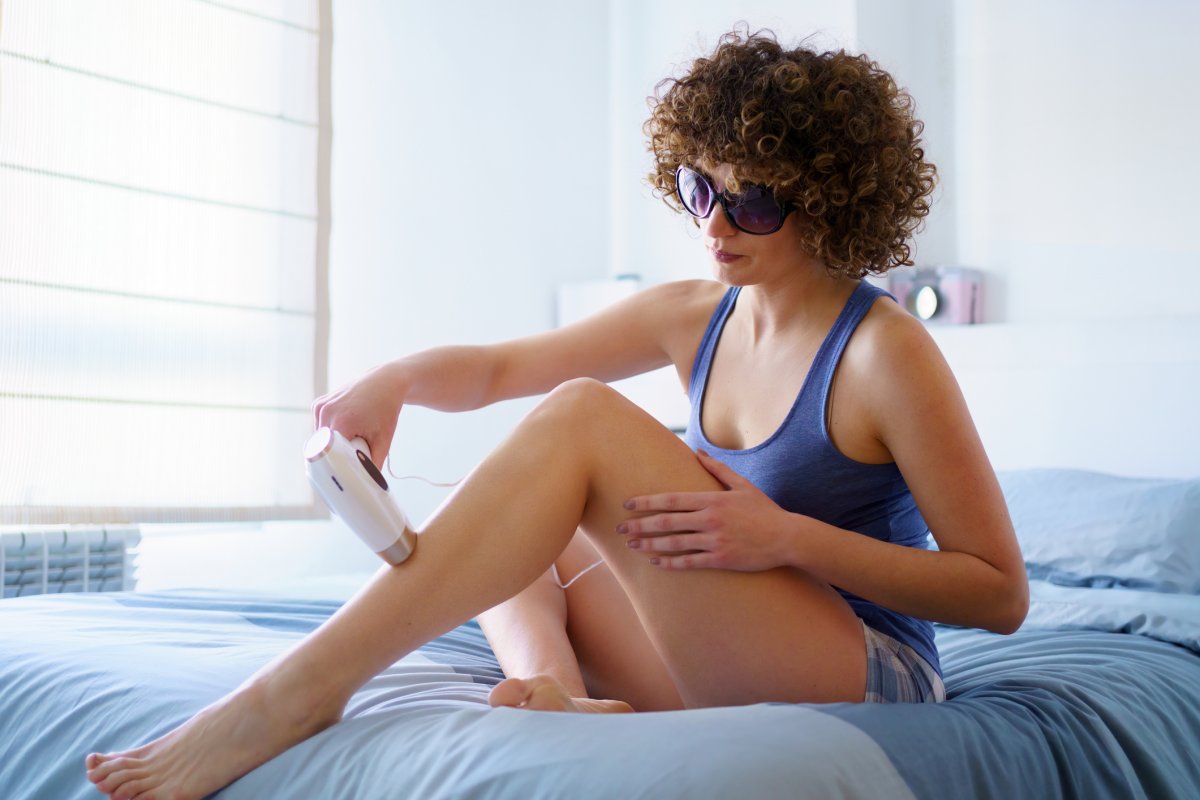When at-home laser and intense pulsed light (IPL) devices were first launched on the market, people jumped at the chance to easily reduce their hair growth.
While these devices seem like a no-brainer for those looking to get rid of body hair once and for all, a master esthetician is issuing a word of warning for those thinking of investing without understanding the damage they can cause.
Britain Layton shared a TikTok video to highlight "why it's so important you go to a licensed professional," noting that "the stories I've heard from other estheticians are crazy."
She shared a series of images of people who had been left with burns and scarring from these controversial devices, with the video reaching 617,000 views and 32,000 likes since it was shared the her account (@britain.skincare) in May.
"This is what can happen to your legs or any other body part if you decide to buy an at-home laser hair removal machine," warned Layton.
"I see them all over TikTok, all over Instagram, everyone saying how great they are and how they don't have hair anymore, but they don't understand like the wavelengths and the actual settings and the science and everything behind the actual laser itself.
"You can end up with third-degree burns just like this that don't go away on their own."
@britain.skincareWhy its so important yo go to a licensed professional! Im a medical master esthetician and the stories ive heard from other estheticians are crazy! #skincare #fyp #lhr
♬ original sound - Britains.skincare
Layton isn't the only professional with concerns over the at-home use of devices like these.
"The IPL at-home device is more for convenience as it allows you to carry out the treatment in the comfort of your own home," Victoria Phelps, interim learning and capability manager for Laser Clinics UK, told Newsweek. "However, if the instructions haven't been read properly and the aftercare hasn't been followed correctly it can lead to unwanted reactions or side effects."
Giving some insight into the example images from the video, Phelps shared:
"With these reactions it seems the skin is holding onto the heat from the settings used being incorrect and has created thermal damage or a burn. In particular, the ladies face in this video this would have been an error in the settings used not being for her skin type and has attracted to the pigment in their skin causing hypopigmentation.
"Hypopigmentation is when the melanocytes that produces your skin color is damaged through trauma, in this case too much heat from the device as the wavelength and settings used were wrong for the client. It is a long road to recovery when this occurs and takes patience and treating the area quickly to prevent long term damage," she said.
Phelps explained that professional-grade devices allow practitioners to have more control over the wavelength released from the machines, while at-home alternatives don't offer the same personalization.

"At-home devices use IPL which stands for intense pulsed light. IPL is a broad spectrum of light that has multiple wavelengths rather than just one wavelength of light selected, which leads to the IPL being scattered and indirect and can lead to not just the hair being targeted," Phelps said.
"IPL works by targeting the pigment in the hair which then heats the hair to a certain temperature, but where IPL is scattered and indirect due to multiple wavelengths IPL doesn't just target the hair and isn't for everyone's skin type.
"It's important to understand for these treatments to be effective the hair must be black or brown in pigment. These will not work on blonde, gray, red or fluffy hairs."
If you still want to try the at-home option, Phelps said that "it is always important to read the instructions carefully and follow them to ensure the safety of your skin. Often, clients start to use these devices and may have not followed the pre- and post-care correctly."
Key ways to prepare the skin for laser treatments include ensuring there is has been no fake tan or traces of sun exposure on the treatment area, as well as avoiding active ingredients for up to five days prior and avoiding using barrier-creating creams, oils and makeup. Aftercare is another important element of a successful session, with hot baths, saunas, steam rooms, and exercise off limits for 48 hours, as well as exfoliation and the use of active ingredients.
"Ensuring you have followed the pre and post-care correctly will help to prevent any stronger skin reaction," Phelps said. "My professional advice to anyone who results in a stronger skin reaction after using an at-home device would be to keep the area cool as much as possible using sterile, cool compresses to the area and continue until the heat calms down, wear loose clothing on the area affected and only cotton underwear on intimate areas."
If you ever notice the treated area blistering, feel sore, or unwell after both at-home or professional hair removal, it's best to consult a medical professional.
Request Reprint & Licensing Submit Correction View Editorial Guidelines
About the writer
Lollie Hancock
Lollie is Newsweek's Beauty and Self Care Reporter based in London, U.K. In her role, she covers a range of ... Read more
To read how Newsweek uses AI as a newsroom tool, Click here.





































